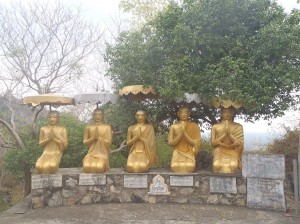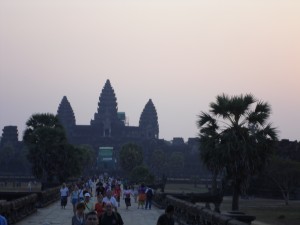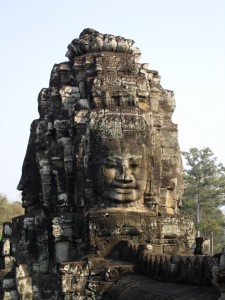According to Mr. Bat, a family that fled Cambodia during the Khmer Rouge occupation was found a few years ago in the jungles of northern Laos. They didn’t know the reign of terror was over. Twenty to thirty years “over”, depending on who you ask. Turns out their youngest child had spent all 16 years of her life roughing it in the jungle without cause.
Mr. Bat was the genial, early-40’s, grinning guide with whom I struck up an immediate friendship. I got his jokes, he got mine, and soon we were piling into his tuk-tuk to be shown around the city of Battambang for $5.
This former French-colonial city, is where we fetched up a few hours after crossing the Thai/Cambodian border. We ate pizza while Mr. Bat drove us around. Most interesting: the stupas (small towers) outside of wats (temples) are basically giant urns where all of a family’s ashes are interred. He even showed us the crematorium!
In the morning, Mr. Bat showed us the ropes at a noodle shop in a rural village. The whole length of the route we passed farmer’s flat-bed trailers loaded down with bags of straw and grain. The contraption was powered by a motor and driver’s seat mounted perilously far out in front of the cart, like the simple-farmer version of a West Coast Chopper. Putting down the back roads to the winery, children shouted cheerful “hellos” and we answered. The wine was mediocre, the brandy strong, the ginger tonic potent and spicy, and the grape juice incredible. Next and last, we slogged up a butte with several temple complexes overlooking the surrounding area. A cave contained a memorial to those who were killed and dropped in through an opening in the ceiling by the Khmer Rouge. Mr. Bat told us the story of a survivor.
Our tour finished and we hopped a bus to Siem Reap, having forgone “Cambodia’s most enchanting boat trip.” The bus takes 3 hours and involves cushioned seats. The boat trip is a 9 hour minimum on hard wooden benches. Our reward for choosing comfort was an entire evening of free time. We spent most of it in a euphoric daze at an out-of-place Mexican restaurant. Salsa, avocados, corn tortillas, beans, cheese… oh how I’ve missed you! $1.50 margaritas guaranteed starting the next morning pre-sunrise to see the temples of Angkor Wat wasn’t going to be easy.
Half asleep and still swallowing eggs and toast, we piled into our hired tuk-tuk at 6:30 a.m. We paid Sohmai $12 to drive us to Angkor Wat, Angkor Thom, and Ta Phrom. I’ve been once before, but the sunrise start was a totally different scene. The Japanese tourists, all wearing surgical masks, were hilarious. The top tier inside the namesake temple was open only to us earlybirds. Guards were stationed outside the most sacred temples to turn away any scantily clad tourists who might offend the Gods. Most of said tourists had the nerve to storm away furiously, spitting out anger-fueled diatribes about how “ridiculous” it is for the Cambodians to insist that foreigners follow the old “do as the Romans do” nugget of wisdom.
The temples were as beautiful as before, save for Ta Phrom. This place once famous for showcasing the almighty power of the jungle and mother nature is being restored to its original glory. The temple-eating trees are slowly coming down, and the shamble of stone blocks are being organized and pieced back together. In a few more years, it will be just another temple.
In conversation on the way home, Shomai, told us that the $20 entrance fee does nothing to help the Cambodian people or the ancient temples. A few internet searches later proved him right. A cynical blogger, who has yet to be blocked by the Cambodian government, tells told all: how temple restoration is funded through partnerships with international governments; how a hotel chain is contracted to manage the site and pockets most the profits; how the percentage of profits that do go to the government actually fund a militant arm that ensures through brute force that none of the locals within reach of the temple area develop their properties in any way — lest foreigners see the poverty situation improving and stop sending aid. I’m convinced that at least the gist of all of this is true, since a related article on a website dedicated to exposing corruption issues within the Cambodian government was blocked for users within Cambodia (but not for friends who tried the link in the U.S., Mongolia, Philippines, and Germany).
So that was Cambodia, this time around. We ate dinner, Beth and I browsed the night market, and in the morning we headed for Bangkok, leaving Pat to enjoy other parts of the country. ♣
Photos here of Battambang (border, temples, wine tasting, noodle shack).
Photos here of Siem Reap and Angkor Wat (margarita night, famous temples, painted elephants).









Twitter Facebook Google+ StumbleUpon Reddit Pinterest